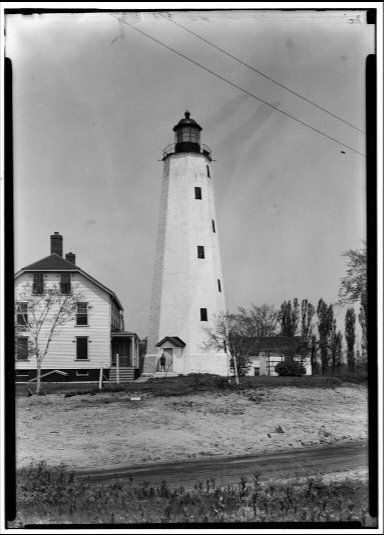Sandy Hook Lighthouse
There isn’t anyone around who doesn’t love the Sandy Hook Lighthouse and know at least five different facts about it. But now the Department of History and Anthropology at Monmouth University is offering something pretty exciting that proves once again that with History, there is always some current Happening. The Lighthouse, for those who may not be aware, is the oldest working lighthouse in the entire country. Built in 1764 and designed by Isaac Conro, becoming the work for which he is best remembered, it remains the oldest standing navigational aid in the entire country, and was built so solidly that in 1852, a Congressional inquiry determined it to be one of the three best-built lighthouses in America. A half century before, General Washington had written the walls were so thick they were impenetrable. When built, the lighthouse stood about 500 feet from the tip of Sandy Hook; over the centuries the Hook grew through littoral drift, and while the lighthouse didn’t move, it’s now close to a mile and a half from the tip of the Hook. Because of this, the earth beneath and around the Lighthouse holds marvelous secrets, and Dr. Richard Veit’s inquisitive archeological sleuths are hopeful of uncovering some of them. And even better, Dr. Veit is inviting all interested curious workers who want to try their own hand at a bit of the dig to join in! Beginning Saturday, May 28, and for every Saturday during June, from 9 a.m. to 4 p.m, these industrious and inquisitive college students will be combing the earth for a two acre area around the Lighthouse to see what treasures they can uncover. Dr. Veit noted the possibilities are endless: this was the first land Henry Hudson saw in 1609, it has always been the gateway to New York and the eye for navigators on the water and could hold remnants of ships that were tossed, turned, or spilt their goods along the shores of the Hook. It was home to many Europeans in the early part of the 1700s, and a British stronghold during the American Revolution. As such, there were many Loyalists who sought refuge on the Hook from the enthusiastic retaliation of American Patriots; runaway slaves sought out the Hook to work with the British and hopefully gain their freedom. It was there for the Spanish American War in the 19th century when Fort Hancock was established, and through the 20th century, playing important roles in every war from then through the Cold War era and Nike Missiles until its closure in 1974. At a meeting last week of the Fort Hancock 21st Century Advisory Committee, Dr. Veit said the general public is invited to drop in any of those Saturday mornings a bit after 9 a.m. and he could put them to work learning something about archeology and how to search for hidden wonders. Guests are invited to stay as long or as short as they’d like, he said, adding with a smile that “of course the students will be there from 9 to 4.” Reservations aren’t needed and no experience is necessary, but the memory of a day on a dig could last a lifetime. The students, under Dr. Veit’s tutelage, and with the blessing of both the Advisory Committee and the National Park Service, are doing their dig before construction work starts on the foundation of the Lighthouse, which is in need of serious work. The professor said some of the two acres laid out for the archeological work includes some of the land that was at the water’s edge in an earlier era, but most of it is land that was trod, fired upon, lived on, and part of someone’s everyday life. Dr. Veit said the late Dan Seitz’ Hartshorne Papers, which the Hartshorne descendant bequeathed to the Monmouth County Historical Association, have been a treasure trove of information. For instance, from the Hartshorne Papers, Dr. Veit learned that at one time there were five different lighthouse keeping cottages on site, so “who knows what could turn up from everyday life from that era?” Whatever artifacts are found or uncovered, of course, remain the property of the National Park Service, but be they buttons or badges, coins or glass, china shards or belt buckles, they all hold a story of the people who lived or visited there in an earlier time. The lighthouse on the land known as Refugee Town during the Revolution may have been on a US postal stamp in the 1990s, might even have been the backdrop for a soap opera in the 20th century. The land under it may have been purchased from the Hartshornes with funds raised through a national lottery. But now, in the summer of the 21st century, today’s historians, archeologists and just plain folks who love Sandy Hook, can have the opportunity to hunt, in the name of the Park Service, for bits and treasures that hold the stories of the centuries.

PHOTO: Historic American Buildings Survey Nathaniel R. Ewan, Photographer May 10, 1937 EXTERIOR - SOUTH VIEW - Sandy Hook Lighthouse, Fort Hancock, Fort Hancock, Monmouth County, NJ Photos from Survey HABS NJ-326
